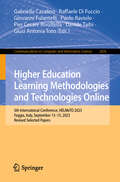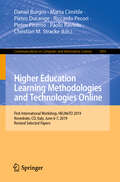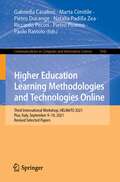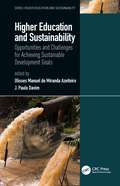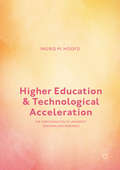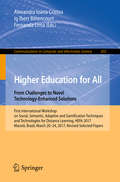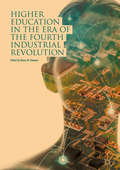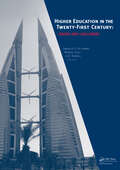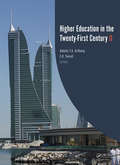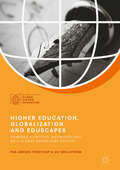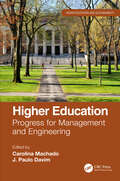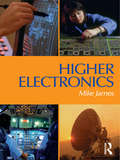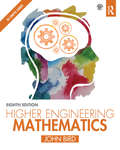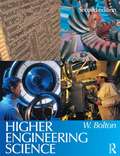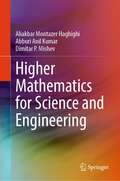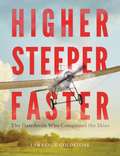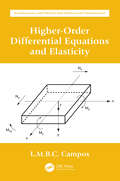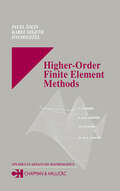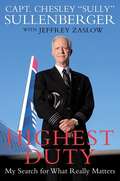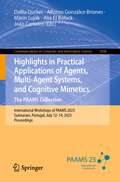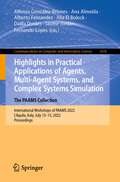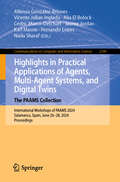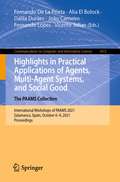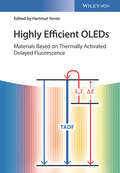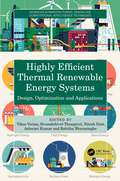- Table View
- List View
Higher Education Learning Methodologies and Technologies Online: 5th International Conference, HELMeTO 2023, Foggia, Italy, September 13–15, 2023, Revised Selected Papers (Communications in Computer and Information Science #2076)
by Paolo Raviolo Davide Taibi Gabriella Casalino Raffaele Di Fuccio Giusi Antonia Toto Giovanni Fulantelli Pier Cesare RivoltellaThis volume constitutes the refereed proceedings of the 5th International Workshop, HELMeTO 2023, held in Foggia, Italy, during September 13–15, 2023. The 52 full papers were carefully reviewed and selected from 107 submission. They are categorized in the following sections: Online pedagogy and learning methodologies and Learning technologies data analytics and educational big data mining and their applications, Smart Systems for Context-aware Education, Emotions and Art in Higher Distance Education and Performing art based methodology to improve online learning experiences, E learning for providing augmented mathematics education at University level, SuperCyberKids the importance of promoting Cybersecurity Education among teacher education students, Effects of High performance Artificial Intelligence systems and Immersive Technologies in Education, The Future of Learning Exploring the Intersection of Posthumanism E Health Technologies and Artificial Intelligence in Education Innovations, Technology based learning interventions in higher education for combating inequalities and increasing the psychological well being of youngsters, Innovative Inclusive University, Beyond borders: exploring immersive environments and new didactic approaches in higher education, Learning Technologies and Faculty Development in the digital framework.
Higher Education Learning Methodologies and Technologies Online: First International Workshop, HELMeTO 2019, Novedrate, CO, Italy, June 6-7, 2019, Revised Selected Papers (Communications in Computer and Information Science #1091)
by Daniel Burgos Riccardo Pecori Marta Cimitile Pietro Ducange Pietro Picerno Paolo Raviolo Christian M. StrackeThis book constitutes the thoroughly refereed post-conference proceedings of the First International Workshop on Higher Education Learning Methodologies and Technologies Online, HELMeTO 2019, held in Novedrate, Italy, in June 2019. The 15 revised full papers and 2 short papers presented were carefully reviewed and selected from a total of 39 submissions. The papers are organized in topical sections on online pedagogy and learning methodologies; learning technologies, data analytics and educational big data mining as well as their applications; the challenge of online sport and exercise sciences university programs.
Higher Education Learning Methodologies and Technologies Online: Third International Workshop, HELMeTO 2021, Pisa, Italy, September 9–10, 2021, Revised Selected Papers (Communications in Computer and Information Science #1542)
by Riccardo Pecori Marta Cimitile Pietro Ducange Pietro Picerno Paolo Raviolo Gabriella Casalino Natalia Padilla ZeaThis book constitutes the thoroughly refereed post-conference proceedings of the Third International Workshop on Higher Education Learning Methodologies and Technologies Online, HELMeTO 2021, held in Pisa, Italy, in September 2021. Due to the COVID-19 pandemic the conference was held online. The 26 revised full papers and 3 short papers presented were carefully reviewed and selected from a total of 65 submissions. The papers present recent research on challenges of implementing emerging technology solution for online, online learning pedagogical frameworks, facing COVID19 emergency in higher education teaching and learning, online learning technologies in practice, online learning strategies and resources, etc.
Higher Education and Sustainability: Opportunities and Challenges for Achieving Sustainable Development Goals (Higher Education and Sustainability)
by J. Paulo Davim Ulisses Manuel De Miranda AzeiteiroThe book provides descriptions of experiences from research and educational sustainability projects and the role HEIs can play together with contributions presenting a variety of initiatives showing how SDGs are being implemented. The book promotes the theoretical and practical understanding on this thematic and disseminates knowledge and international research and cooperation. Contributions cover the role of SDGs in advancing implementation of sustainable development, sustainability in higher education, the role of universities in sustainable development, new paths towards sustainable development and e-learning contributions. Features Focuses on theoretical and practical understanding on Sustainability, Higher Education and SDGs to disseminate knowledge and promote research and cooperation Includes lessons learned from sustainability research and educational challenges presenting case studies, technological developments, outputs of research and studies, best practices and examples of successful projects Discusses relevant and international perspectives on sustainability, higher education and SGDs Presents local and international contributions on a variety of initiatives showing how SDGs are being implemented
Higher Education and Technological Acceleration: The Disintegration of University Teaching and Research
by Ingrid M. HoofdThis book critically examines the relationship between new media technologies, research ethics, and pedagogical strategies within the contemporary university. It debates whether recent transformations of higher education, rather than an effect of neo-liberalization, are actually an outflow of the technological acceleration of the university's own contradictory ideals around knowledge and democracy. The book sets up this argument by likening the university to a "vision machine" which quest for total scientific and social transparency has recently caved in on itself, negatively affecting staff and student well-being. The book asserts that this situation reveals the essential tension at the heart of the university system, and explores the acceleration of this tension by analyzing a variety of teaching and research advances from Europe and Asia. Examining among other issues the call for creativity and critical thinking in the curriculum, the push for e-learning, and the advent of the digital humanities, this text offers a key analysis of the university's founding ideals and its constitutive relationship to technological acceleration.
Higher Education for All. From Challenges to Novel Technology-Enhanced Solutions: First International Workshop On Social, Semantic, Adaptive And Gamification Techniques And Technologies For Distance Learning, Hefa 2017, Maceió, Brazil, March 20-24, 2017, Revised Selected Papers (Communications In Computer And Information Science #832)
by Alexandra Ioana Cristea Ig Ibert Bittencourt Fernanda LimaThis book constitutes the thoroughly refereed proceedings of the Researcher Links Workshop: Higher Education for All, held in Maceió, Brazil, in March 2017. The 12 full papers presented were carefully reviewed and selected from 31 submissions. The papers deal with a large spectrum of topics, including higher education, technology-enhanced solutions, user modelling, user grouping, gamification, educational games, MOOCs, e-learning, open educational resources, collaborative learning, student modelling, serious games, language analysis.
Higher Education in the Era of the Fourth Industrial Revolution
by Nancy W. GleasonThis open access collection examines how higher education responds to the demands of the automation economy and the fourth industrial revolution. Considering significant trends in how people are learning, coupled with the ways in which different higher education institutions and education stakeholders are implementing adaptations, it looks at new programs and technological advances that are changing how and why we teach and learn. The book addresses trends in liberal arts integration of STEM innovations, the changing role of libraries in the digital age, global trends in youth mobility, and the development of lifelong learning programs. This is coupled with case study assessments of the various ways China, Singapore, South Africa and Costa Rica are preparing their populations for significant shifts in labour market demands – shifts that are already underway. Offering examples of new frameworks in which collaboration between government, industry, and higher education institutions can prevent lagging behind in this fast changing environment, this book is a key read for anyone wanting to understand how the world should respond to the radical technological shifts underway on the frontline of higher education.
Higher Education in the Twenty-First Century
by E. H. Twizell Abdulla Y. Al-Hawaj Wajeeh ElaliThe skills, creativity, and research developed through higher education are major factors in any society‘s success in creating jobs and advancing prosperity. Universities and colleges play a vital r le in expanding opportunity and promoting social justice. The papers in this book reflect the main objective of a conference held in June 2007 at Ahlia
Higher Education in the Twenty-First Century II
by E. H. Twizell Abdulla Y.A. Al-HawajAhlia University contributes to the advancement and propagation of knowledge by encouraging its academics and research students to publish their original research that can be applied to real-life situations. Co-operation with Brunel University London in the United Kingdom led to the establishing of a Ph.D. programme at Ahlia University in 2005.An i
Higher Education, Globalization and Eduscapes: Towards A Critical Anthropology Of A Global Knowledge Society (Palgrave Studies in Global Higher Education)
by Per-Anders Forstorp Ulf MellströmThis book examines transnational scapes and flows of higher education: arguing that the educational and political vision of a national, regional and global knowledge society needs to be perspectivized beyond its ethnocentric conditions and meanings. Using eduscapes as its most important concept, this book explores the educational landscapes of individual as well as institutional actors; particularly the agential aspects of how global eduscapes are imagined, experienced, negotiated and constructed. In addition, the authors highlight the critical potential of anthropology, using this perspective as a resource for cultural critique where the Western experience and assumed ‘ownership’ of the global knowledge economy will be put into question. This comprehensive book will appeal to students and scholars of educational policy, the sociology of education and the globalization of education.
Higher Education: Progress for Management and Engineering (Higher Education and Sustainability)
by Carolina MachadoIncreasing corporate social responsibility demands professionals possess the necessary knowledge, abilities, and competencies to answer the needs of a diverse organization’s stakeholders. This book highlights the most recent issues related to higher education in the fields of management and engineering. It explains why a sustainable education is a requirement for professionals, as well as the organizations they collaborate with.Higher Education: Progress for Management and Engineering focuses on the latest research findings in the field of higher and sustainable education. It discusses the progress, shares knowledge and insights on an international scale, and highlights the challenges faced to obtain and secure a more responsible and sustainable management system. Selecting different options and strategies, how to set priorities on managing competition, and how to succeed as an organization that can lead to successes in both national and international markets are covered within this book.This book can be used as a reference for researchers, academics, managers, engineers, and other professionals involved in higher and sustainable education in management and engineering.
Higher Electronics
by Mike JamesHigher Electronics is a comprehensive text for electronics undergraduates, covering analogue, digital electronics and microelectronics in a single volume - at a level suitable for most first and second year modules. The text is highly student-centred, providing numerous· worked examples with step-by-step guidance and hints· highlighted key facts and points of interest· self-check questions scattered through the text· problem sections (with answers supplied)It has been written to suit courses with an intake from a range of educational backgrounds, and a minimum of prior knowledge is assumed. Higher Electronics has been written to be fully in line with units 8-12 of the new BTEC Higher National specifications from Edexcel. This makes it the text of choice for all students following an electronics / electrical pathway through an HNC or HND. The student-centred text is ideal for the new course, and follows on especially well for students from a GNVQ background. The style and approach of Higher Electronics is consistent with the new text from Newnes, Higher National Engineering, which covers the mandatory units (units 1-7) of the new Higher National scheme.
Higher Engineering Mathematics
by John BirdNow in its eighth edition, Higher Engineering Mathematics has helped thousands of students succeed in their exams. Theory is kept to a minimum, with the emphasis firmly placed on problem-solving skills, making this a thoroughly practical introduction to the advanced engineering mathematics that students need to master. The extensive and thorough topic coverage makes this an ideal text for upper-level vocational courses and for undergraduate degree courses. It is also supported by a fully updated companion website with resources for both students and lecturers. It has full solutions to all 2,000 further questions contained in the 277 practice exercises.
Higher Engineering Science
by W. Bolton W BoltonHigher Engineering Science aims to provide students with an understanding of the scientific principles that underpin the design and operation of modern engineering systems. It builds a sound scientific foundation for further study of electronics, electrical engineering and mechanical engineering.The text is ideal for students, including numerous features designed to aid student learning and put theory into practice:* Worked examples with step-by-step guidance and hints* Highlighted key points, applications and practical activities* Self-check questions included throughout the text* Problems sections with full answers suppliedFurther worked examples, applications, case studies and assignments have also been incorporated into this second edition.Assuming a minimum of prior knowledge, the book has been written to suit courses with an intake from a range of educational backgrounds. The new edition has been designed specifically to cater for the compulsory core Engineering Science unit for HNC and HND qualifications, and updated throughout to match the syllabus of the new BTEC Higher National Engineering schemes from Edexcel. It will also prove ideal for introductory science modules in degree courses.
Higher Mathematics for Science and Engineering
by Aliakbar Montazer Haghighi Dimitar P. Mishev Abburi Anil KumarThis textbook provides a comprehensive, thorough and up-to-date treatment of topics of mathematics that an engineer and scientist would need, at the basic levels that contents of engineering and sciences are built by. For this purpose, natural readers would be junior and senior undergraduate students, who normally have the content of this book under different names on their degree plans. Also, engineers and scientists will benefit from this book since the book is a comprehensive volume for such audiences.This book is written in a way that it balances both theory and practical applications of topics from linear algebra, matrix theory, calculus of multivariable, theory of complex variables, several transforms, ordinary and partial differential equations, difference equations, optimization, probability, statistics, theory of reliability and finally, applications from variety of areas of sciences and engineering.
Higher, Steeper, Faster: The Daredevils Who Conquered the Skies
by Lawrence GoldstoneDiscover the daring aviation pioneers who made the dream of powered flight a reality, forever changing the course of history. Aviator Lincoln Beachey broke countless records: he looped-the-loop, flew upside down and in corkscrews, and was the first to pull his aircraft out of what was a typically fatal tailspin. As Beachey and other aviators took to the skies in death-defying acts in the early twentieth century, these innovative daredevils not only wowed crowds, but also redefined the frontiers of powered flight. Higher, Steeper, Faster takes readers inside the world of the brave men and women who popularized flying through their deadly stunts and paved the way for modern aviation. With heart-stopping accounts of the action-packed race to conquer the skies, plus photographs and fascinating archival documents, this book will exhilarate readers as they fly through the pages.
Higher-Order Differential Equations and Elasticity (Mathematics and Physics for Science and Technology)
by Luis Manuel Braga da Costa CamposHigher-Order Differential Equations and Elasticity is the third book within Ordinary Differential Equations with Applications to Trajectories and Vibrations, Six-volume Set. As a set, they are the fourth volume in the series Mathematics and Physics Applied to Science and Technology. This third book consists of two chapters (chapters 5 and 6 of the set). The first chapter in this book concerns non-linear differential equations of the second and higher orders. It also considers special differential equations with solutions like envelopes not included in the general integral. The methods presented include special differential equations, whose solutions include the general integral and special integrals not included in the general integral for myriad constants of integration. The methods presented include dual variables and differentials, related by Legendre transforms, that have application in thermodynamics. The second chapter concerns deformations of one (two) dimensional elastic bodies that are specified by differential equations of: (i) the second-order for non-stiff bodies like elastic strings (membranes); (ii) fourth-order for stiff bodies like bars and beams (plates). The differential equations are linear for small deformations and gradients and non-linear otherwise. The deformations for beams include bending by transverse loads and buckling by axial loads. Buckling and bending couple non-linearly for plates. The deformations depend on material properties, for example isotropic or anisotropic elastic plates, with intermediate cases such as orthotropic or pseudo-isotropic. Discusses differential equations having special integrals not contained in the general integral, like the envelope of a family of integral curves Presents differential equations of the second and higher order, including non-linear and with variable coefficients Compares relation of differentials with the principles of thermodynamics Describes deformations of non-stiff elastic bodies like strings and membranes and buckling of stiff elastic bodies like bars, beams, and plates Presents linear and non-linear waves in elastic strings, membranes, bars, beams, and plates
Higher-Order Finite Element Methods (Studies in Advanced Mathematics)
by Pavel Solin Karel Segeth Ivo DolezelThe finite element method has always been a mainstay for solving engineering problems numerically. The most recent developments in the field clearly indicate that its future lies in higher-order methods, particularly in higher-order hp-adaptive schemes. These techniques respond well to the increasing complexity of engineering simulations and
Highest Duty: My Search for What Really Matters
by Jeffrey Zaslow Chesley B. SullenbergerIn this inspirational autobiography, Captain "Sully" Sullenberger, the airline pilot whose emergency landing on the Hudson River earned the world's admiration, tells his life story and talks about the essential qualities that he believes have been so vital to his success. In January 2009, the world witnessed one of the most remarkable emergency landings in history when Captain Sullenberger brought a crippled US Airways flight onto the Hudson River, saving the lives of all of the passengers and crew aboard. The successful outcome was the result of effective teamwork, Sully's dedication to airline safety, his belief that a pilot's judgment must go hand-in-hand with-- and can never be replaced by-- technology, and forty years of careful practice and training. From his earliest memories of learning to fly as a teenager in a crop duster's single-engine plane in the skies above rural Texas to his years in the United States Air Force at the controls of a powerful F-4 Phantom, Sully describes the experiences that have helped make him a better leader, particularly the importance of taking responsibility for everyone in his care. And he talks about what he believes is at the heart of America's "can do" spirit: the very human drive to prepare for the unexpected and to meet it with optimism and courage. His wife, Lorrie, has been a pillar of support through all the highs and lows that life has offered, from the challenges of commercial flying to the birth of their two daughters, from financial struggles to the event of January 15, 2009. Though the world may remember Sully as the hero of Flight 1549, the legacy he desires even more is that of a loving husband and father. Highest Duty is the intimate story of a man who has grown up to embrace what we think of as quintessential American values-- leadership, responsibility, commitment to hard work, and service to others. And it is a narrative that reminds us that cultivating seemingly ordinary virtues can prepare us to perform extraordinary acts. 31 pages of photo captions are included at the end.
Highlights in Practical Applications of Agents, Multi-Agent Systems, and Cognitive Mimetics. The PAAMS Collection: International Workshops of PAAMS 2023, Guimaraes, Portugal, July 12–14, 2023, Proceedings (Communications in Computer and Information Science #1838)
by Dalila Durães Marin Lujak Alfonso González-Briones Alia El Bolock João CarneiroThis book constitutes the refereed proceedings of the International Workshops on Highlights in Practical Applications of Agents, Multi-Agent Systems, and Cognitive Mimetics. The PAAMS Collection, PAAMS 2023, held in Guimaraes, Portugal, during July 12–14, 2023.The 14 full papers included in this book were carefully reviewed and selected from 26 submissions. They were organized in topical sections as follows: provides a unique opportunity to bring multi-disciplinary experts, academics, and practitioners together to exchange their experience in the development of agents and multi-agent systems.
Highlights in Practical Applications of Agents, Multi-Agent Systems, and Complex Systems Simulation. The PAAMS Collection: International Workshops of PAAMS 2022, L'Aquila, Italy, July 13–15, 2022, Proceedings (Communications in Computer and Information Science #1678)
by Fernando Lopes Ana Almeida Dalila Durães Alfonso González-Briones Alia El Bolock Alberto Fernandez Jaume JordánThis book constitutes the proceedings of the workshops co-located with the 20th International Conference on Practical Applications of Agents and Multi-Agent Systems, PAAMS 2022, held in L'Aquila, Italy, in July 2022.The total of 25 full papers presented in this volume were carefully reviewed and selected from 39 submissions.The papers in this volume stem from the following meetings: Workshop on Artificial Intelligence for Industry (AI4Industry); Workshop on Adaptive Smart areaS and Intelligent Agents (ASSIA); Workshop on Character Computing (C2); Workshop on Deep Learning Applications (DeLA); Workshop on Decision Support, Recommendation, and Persuasion in Artificial Intelligence (DeRePAI); Workshop on Multi-agent based Applications for Modern Energy Markets, Smart Grids and Future Power Systems (MASGES).
Highlights in Practical Applications of Agents, Multi-Agent Systems, and Digital Twins: International Workshops of PAAMS 2024, Salamanca, Spain, June 26–28, 2024, Proceedings (Communications in Computer and Information Science #2149)
by Fernando Lopes Alfonso González-Briones Alia El Bolock Karl Mason Vicente Julian Inglada Cedric Marco-Detchart Jaume Jordan Nada SharafThis book constitutes the refereed proceedings of the International Workshops on Practical Applications of Agents and Multi-Agent Systems, PAAMS 2024, held in Salamanca, Spain, during June 26–28, 2024. The 32 full papers presented here were carefully reviewed and selected from 44 submissions. Papers from the following workshops have been included in these proceedings: - Workshop on Adaptive Smart areaS and Intelligent Agents (ASSIA) Workshop on Character Computing (C2) Workshop on Cognitive Assistants and Data Fusion (CogniBlend) Workshop on Decision Support, Recommendation, and Persuasion in Artificial Intelligence (DeRePAI) Workshop on Intelligent Agents in Science and Engineering (IASE) Workshop on Modelling and Simulation of Modern Energy Markets and Future Power Systems (MASES) Workshop on Digital Twinning for training purposes in Industry 4.0 (Twin4Train)
Highlights in Practical Applications of Agents, Multi-Agent Systems, and Social Good. The PAAMS Collection: International Workshops of PAAMS 2021, Salamanca, Spain, October 6–9, 2021, Proceedings (Communications in Computer and Information Science #1472)
by Vicente Julian Fernando Lopes Fernando De La Prieta Dalila Durães Alia El Bolock João CarneiroThis book constitutes the proceedings of the workshops co-located with the 19th International Conference on Practical Applications of Agents and Multi-Agent Systems, PAAMS 2021, held in Salamanca, Spain, in October 2021.The total of 17 full and 9 short papers presented in this volume were carefully selected from 42 submissions.The papers in this volume stem from the following meetings:Workshop on Character Computing (C2); Workshop on Deep Learning Applications (DeLA); Workshop on Decision Support, Recommendation, and Persuasion in Artificial Intelligence (DeRePAI); Workshop on Multi-agent based Applications for Modern Energy Markets, Smart Grids and Future Power Systems (MASGES); Workshop on Smart Cities and Intelligent Agents (SCIA).
Highly Efficient OLEDs: Materials Based on Thermally Activated Delayed Fluorescence
by Hartmut YersinThe essential resource that offers a comprehensive understanding of OLED optimizations Highly Efficient OLEDs. Materials Based on Thermally Activated Delayed Fluorescence (TADF) offers substantial information on the working principle of OLEDs and on new types of emitting materials (organic and inorganic). As the authors explain, OLEDs that use the Singlet-Harvesting mechanism based on the molecular property of TADF work according to a new exciton harvesting principle. Thus, low-cost emitter materials, such as Cu(I) or Ag(I) complexes as well as metal-free organic molecules, have the potential to replace high-cost rare metal complexes being currently applied in OLED technology. With contributions from an international panel of experts on the topic, the text shows how the application of new TADF materials allow for the development of efficient OLED displays and lighting systems. This new mechanism is the gateway to the third-generation of luminescent materials. This important resource: Offers a state-of-the-art compilation of the latest results in the dynamically developing field of OLED materials Is edited by a pioneer in the field of OLED material technology Contains a detailed application-oriented guide to new low-cost materials for displays and lighting Puts the focus on the emerging fields of OLED technology Written for materials scientists, solid state chemists, solid state physicists, and electronics engineers, Highly Efficient OLEDs. Materials Based on Thermally Activated Delayed Fluorescence offers a comprehensive resource to the latest advances of OLEDs based on new TADF materials.
Highly Efficient Thermal Renewable Energy Systems: Design, Optimization and Applications (Advances in Manufacturing, Design and Computational Intelligence Techniques)
by Ashwani Kumar Nitesh Dutt Vikas Verma Sivasakthivel Thangavel Rohitha WeerasingheThe text comprehensively highlights the latest methodologies, models, techniques, and applications along with a description of modeling, optimization, and experimental works in the energy sector. It further explains key concepts such as finite element analysis tools, hybrid energy systems, mechanical components design, and optimization, solar coupled systems, and vertical heat exchanger.This book• Discusses the role and integration of solar, geothermal, and hydrogen‑based thermal energy storage (TES) technologies in different sectors for space heating and cooling applications.• Covers mechanical modeling and optimization of hybrid energy storage systems for performance improvement and focuses on hydrogen production, storage, and safety measures.• Explores the integration of IoT and global energy interaction technologies, highlighting their potential benefits in driving the transition toward a sustainable and resilient global energy system.• Explains different aspects of clean technologies such as batteries, fuel cells, ground energy storage, solar thermal system, and the role of green hydrogen in decarbonizing sectors like transportation and energy.• Showcases a clear idea of sustainable development using renewable energy, focusing on policymaking, challenges in transition from conventional to renewable energy, and future directions in energy sector.It is primarily written for senior undergraduates and graduate students, and academic researchers in the fields of mechanical engineering, production engineering, industrial engineering, and environmental engineering.
